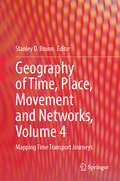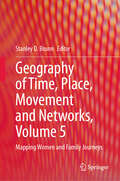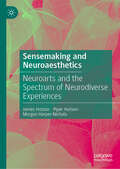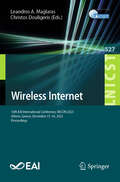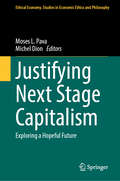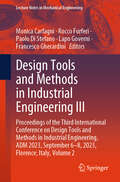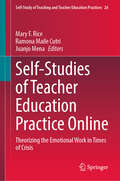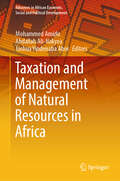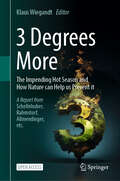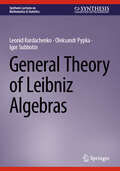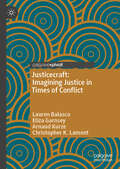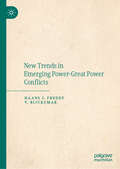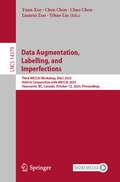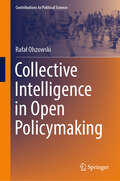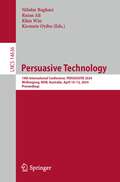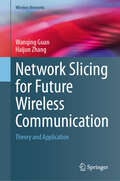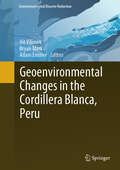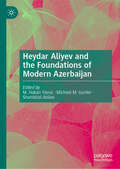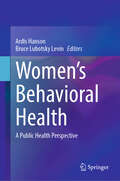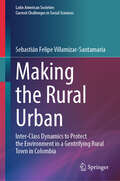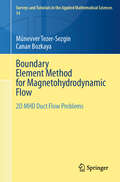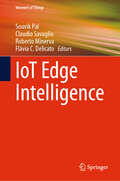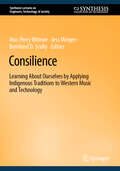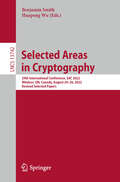- Table View
- List View
Geography of Time, Place, Movement and Networks, Volume 4: Mapping Time Transport Journeys
by Stanley D. BrunnThis book provides insight into the importance of place and place settings in personal journeys. It explores the worlds of time journeys in different contexts: daily work, community livelihoods, rural-urban migration, disease outbreaks and controls, cruise ship tours, and isolated frontier settings. Besides this, the book also addresses the networks connecting rural and urban places, transcontinental highways and railroads, rural-urban migration and other innovative journeys such as gas station road maps and body maps. The chapters also discuss how eradicating diseases are time/place journeys as is moving from a distant isolated frontier to a metropolis. As such, this book is a must read for those interested in exploring the intersections in and between the humanities and social/policy sciences.
Geography of Time, Place, Movement and Networks, Volume 5: Mapping Women and Family Journeys
by Stanley D. BrunnThis book investigates both early as well as recent accounts of journeys by women and families in African, Asian, East European, North and Latin American contexts. It discusses how places, place settings and transport routes, whether by land, sea, or air, were and remain important in the impacts these newcomers have on states and regions. The contributions to this book provide insight in laws and regulations related to women’s and refugees’ rights. They highlight the importance of place and location in defining rights and implementing reforms, such as the importance of the politics and the state in identifying rights in global contexts of refugee resettlement, cross-border employment, security and reshaping human institutions as well as the changing legal landscape related to for instance women participating in the Olympic Games and in national sports. The book also touches on the worlds of family landscapes, mapping family trees, family cemeteries and redefining immigrant city mixes. As such, the book offers readers to explore past, present, and future issues faced by women and families, regardless of place or country.
Sensemaking and Neuroaesthetics: Neuroarts and the Spectrum of Neurodiverse Experiences
by James Hutson Piper Hutson Morgan Harper-NicholsThis book investigates the complex interrelationships between neuroscience, arts, technical design, and the spectrum of neurodivergent conditions, introducing the emerging topic of neuroarts. It emphasizes the power of art and technologies as a multisensory tool for helping neurodivergent individuals discover their sensory preferences, and for neurotypical individuals to broaden their understanding of the world by simulating different sensory experiences. Drawing on the enactivism theory, which posits that cognitive processes are inherently shaped through the dynamic interplay between an organism and its environmental context, the authors discuss the applications of emerging technologies and propose a new theory to discuss and identify ‘neurotribes’ based on their relation to sense making or the body.A timely and well-needed resource for scholars in the fields of neuroaesthetics and neurodiversity, as well as art therapists, clinical psychologists, and medical practitioners specializing in neurodiversity and sensory perception disorders, this book can also serve cultural institutions developing inclusive experiences for a neurodiverse public, and professionals in the tech industry focusing on AI, augmented reality, and sensory technology.
Wireless Internet: 16th EAI International Conference, WiCON 2023, Athens, Greece, December 15-16, 2023, Proceedings (Lecture Notes of the Institute for Computer Sciences, Social Informatics and Telecommunications Engineering #527)
by Leandros A. Maglaras Christos DouligerisThis book constitutes the refereed post-conference proceedings of the 16th International Conference on Wireless Internet, WiCON 2023, held in Athens, Greece, in December 15-16, 2023. The 14 full papers were selected from 35 submissions and are grouped into the following topics: Wireless networks; AI/ML systems; 5G/6G networks; and Digital services.
Justifying Next Stage Capitalism: Exploring a Hopeful Future (Ethical Economy #68)
by Michel Dion Moses L. PavaThis book explores emerging justifications of capitalism based on the views of academics from around the world in business. The traditional justification for capitalism has been that it is the one system that produces the most wealth with the least cost for the most people. While this justification no longer has the taken-for-granted status it once enjoyed, it remains the dominant and mainstream argument in favor of capitalism, especially in the United States. Despite capitalism’s production of human wealth, it is implicated by trends such as income and wealth inequalities, climate change caused by the burning of fossil fuels and racism, sexism and other forms of discrimination. This volume asserts that in this age of complexity, inequality, and ecological instability, capitalism’s future depends on our ability to broaden the justifications for it to include a much more elaborate list of values beyond wealth and efficiency. It does so without claiming tologically or empirically prove that capitalism is the best of all possible economic systems, but rather to explore a new and hopeful future for the system; Next stage capitalism. Written by an international group of scholars from various disciplines, this book is of great interest to those who work in philosophy, sociology, political science, history and theology and religious studies.
Design Tools and Methods in Industrial Engineering III: Proceedings of the Third International Conference on Design Tools and Methods in Industrial Engineering, ADM 2023, September 6–8, 2023, Florence, Italy, Volume 2 (Lecture Notes in Mechanical Engineering)
by Francesco Gherardini Rocco Furferi Lapo Governi Paolo Di Stefano Monica CarfagniThis book gathers original peer-reviewed papers reporting on innovative methods and tools in design, modeling, simulation and optimization, and their applications in engineering design, manufacturing, and other relevant industrial sectors. Based on contributions to the Third International Conference on Design Tools and Methods in Industrial Engineering, ADM 2023, held on September 6–8, 2023, in Florence, Italy, and organized by the Italian Association of Design Methods and Tools for Industrial Engineering, and the Department of Industrial Engineering of the University of Florence, this second volume of a 2-volume set focuses on interdisciplinary topics in design, such as human body acquisition and modelling, human factors and user-centered design, digital factories, and design methods for different engineering applications. All in all, this book provides academics and professionals with a timely overview and extensive information on trends and technologies in industrial design and manufacturing.
Self-Studies of Teacher Education Practice Online: Theorizing the Emotional Work in Times of Crisis (Self-Study of Teaching and Teacher Education Practices #26)
by Juanjo Mena Mary F. Rice Ramona Maile CutriThis edited volume explores the emotional work of being an online teacher educator. The chapter authors discuss the intense work involved in planning, teaching, and navigating intuitional contexts in order to build a relationship between online teaching and the Self-Study of Teacher Educator Practice (S-STEP) methodology. Additionally, the authors of the chapters in the book used the S-STEP methodology to move their practices and their teacher-educator identities beyond emergency/crisis uses of online teaching common during campus building closures. Each chapter offers different ways that S-STEP methodology can be used to sustain oneself as an online teacher educator. Although there are specific strategies and practices, this is not a ‘how-to’ book for online teacher educating—it is an exploration of online teachers and groups of online teachers supporting themselves and each other by studying and learning from their practices.
Taxation and Management of Natural Resources in Africa (Advances in African Economic, Social and Political Development)
by Joshua Yindenaba Abor Mohammed Amidu Abdallah Ali-NakyeaThis book offers a comprehensive examination of the fundamental concepts and principles crucial to the taxation and management of natural resources, specifically tailored to the unique challenges faced by developing African countries. It delves into the key instruments that comprise a resource tax policy, providing invaluable insights into the tax reforms necessary to maximize economic rent for African nations. Written by experts in the field, this book explores the potential application of effective revenue management principles by African governments to achieve desired developmental outcomes. It covers a wide range of topics, including socio-political risks, ethical dilemmas, accountability and transparency, resource rent and capital gains taxes, tax administration and reforms, taxation of oil and gas revenue, environmental taxation, globalization's impact, and the promotion of inclusive development. Designed for scholars, tax professionals, and individuals interested in natural resources management and revenue mobilization strategy in Africa, this book bridges the gap between theory and practice, providing valuable insights and recommendations for sustainable and responsible management of Africa's rich natural resources.
Pediatric Nonadherence: A Solutions Based Approach
by Peter Silver Victor Fornari Ida DancygerNonadherence to pediatric recommendations is a pervasive challenge to the growth, development, and wellbeing of children. Nearly half of all youth and their parents suffer the consequences of misunderstanding, forgetting, ignoring or refusing professional medical advice regarding children. Addressing this widespread dilemma, this unique and comprehensive title explores a variety of different pediatric problems that impact children, adolescents and their families. Clinical case vignettes are provided to highlight particular considerations, and a description of the most up-to-date strategies to solve the dilemma of nonadherence to pediatric care is provided. Indeed, technology is emphasized as an important and innovative means of tracking, interfacing and gathering individual data and facilitating improved pediatric adherence. No one intervention strategy can be applied to solve nonadherence of pediatric patients. Research studies have concluded that successful efforts to enhance adherence rely on a number of important elements. First and foremost is nurturing a trusting relationship between the patient, the family and the clinician, which strengthens the therapeutic alliance. Following that is making sure that the patient and family fully understand the nature of the illness and the recommendations. Effective and clear communication is critical between the health professionals, the patient and the family. When the health professional understands who the patient and the family are on a deeper level, then adherence may be improved. It is imperative that the clinicians take into account the individual patient and families’ cultural, social and community context, as well as their beliefs and support systems. An atmosphere of shared collaboration and mutual respect will improve open communication and the promotion of adherence and positive outcomes. An important thread throughout each chapter is the impact of health care disparities, diversity and equity. The contributors to Pediatric Nonadherence represent a wide range of nationally and internationally recognized experts in their area of pediatric sub-specialization and practice. A major contribution to the clinical literature, this timely title will be of great interest to pediatricians, family practitioners, medical students, residents, fellows, physician assistants, and nurse practitioners.
3 Degrees More: The Impending Hot Season and How Nature Can Help Us Prevent It
by Klaus WiegandtThis open access book describes in detail what life on this planet would be like if its average surface temperature were to rise 3 degrees Celsius above the preindustrial level. On this basis, the book argues that it is imperative to keep this temperature rise below 2 degrees Celsius. It then lays out a detailed plan of what politically feasible, cost-effective measures should now be taken to achieve this goal. In this context, the book provides detailed discussions of climate finance, climate education and nature-based solutions. The book has been translated into English from the original German version published in 2022, and contains an original foreword and preface.
General Theory of Leibniz Algebras (Synthesis Lectures on Mathematics & Statistics)
by Leonid Kurdachenko Oleksandr Pypka Igor SubbotinThis book discusses many interesting results have been obtained in Leibniz algebras over the past two decades. The authors not only summarize recent results and methods successfully used in Leibniz algebras, but also show new prospective horizons. Any mathematical theories have a number of natural problems that arise in the process of its development, and these problems quite often have analogues in other areas such as differential geometry, homological algebra, classical algebraic topology, noncommutative geometry, etc. With this in mind the authors describe the general structure of Leibniz algebras that have already been discovered. This approach allows readers to see which parts of the theory should be developed further and also shows the significant differences of Leibniz algebras from Lie algebras. Recent results that constitute the naturally evolving general theory of the subject are then explored.
Justicecraft: Imagining Justice in Times of Conflict
by Christopher K. Lamont Eliza Garnsey Arnaud Kurze Lauren BalascoThis book is about the making of justice. Despite the growing scholarship on transitional and transformative justice, contested struggles for justice in times of political change fail to get the nuanced attention we think they deserve. It seeks to understand how the making of justice is a craft and how this process of craft making is itself a source of political change. The authors introduce a new and novel conceptual framework of justicecraft which sheds light upon political change by unpacking five key elements—the skills, knowledge, labor, affect, and materiality—involved in contested struggles for justice. Justicecraft illuminates the stories and struggles for justice, enabling a greater understanding of accompanying social, political, and cultural shifts in society which unfold during times of conflict. By framing justice as craft, the authors offer a more fluid understanding of how people are producing justice on the ground—and identify the means, the instruments, the language, and claims involved in the process. Each chapter applies the framework of justicecraft to diverse global case illustrations of struggles against past, present, and future injustices and wrongdoings and draws out the key elements embedded in these processes.
New Trends in Emerging Power-Great Power Conflicts
by Haans J. Freddy V. BijukumarThe rise and fall of states in the international system has been an interesting problem that has received attention amongst scholars, policy makers, journalists, politicians and leaders of states. Interestingly there have been numerous attempts that have sought to define, explain and interpret the consequences of these developments that occur in the international system (Chan, 2008:1). Efforts have been made to define ‘Great Powers’, ‘Middle Powers’, ‘Emerging Powers’, ‘Small Powers’, Super Powers’, ‘Hegemons’ etc, of which the idea of ‘Great Power’ and ‘Emerging Power’, receives primary attention in this research. The dramatic rise of China and India in particular, in terms of their economy and military capabilities, has brought about a paradigm shift in terms of thinking of world politics that is coupled with the decline of the US’ hegemonic status. Randall Schweller points out that there have been arguments that support the fact of the increasing potential for security competition and war between the US and China and on the other hand he also directs the reader to the optimist’s argument that the transition of power would be smooth and evolutionary where there will be efforts towards accommodating these changes that are occurring in the international system. He also points out that there will be efforts by great powers to accept these changes through restraint, reciprocity, cooperation and establish a mutually acceptable order that would benefit all (Schweller, 2011: 285). These complexities make it both interesting as well as a serious concern in terms of peace and security in the world.
Data Augmentation, Labelling, and Imperfections: Third MICCAI Workshop, DALI 2023, Held in Conjunction with MICCAI 2023, Vancouver, BC, Canada, October 12, 2023, Proceedings (Lecture Notes in Computer Science #14379)
by Chen Chen Chao Chen Yuan Xue Lianrui Zuo Yihao LiuThis LNCS conference volume constitutes the proceedings of the 3rd International Workshop on Data Augmentation, Labeling, and Imperfections (DALI 2023), held on October 12, 2023, in Vancouver, Canada, in conjunction with the 26th International Conference on Medical Image Computing and Computer Assisted Intervention (MICCAI 2023). The 16 full papers together in this volume were carefully reviewed and selected from 23 submissions. The conference fosters a collaborative environment for addressing the critical challenges associated with medical data, particularly focusing on data, labeling, and dealing with data imperfections in the context of medical image analysis.
Collective Intelligence in Open Policymaking (Contributions to Political Science)
by Rafał OlszowskiThis book examines the nexus of collective intelligence (CI), a feature of online projects in which various types of communities solve problems intelligently, and open policymaking, as a trend of large groups of people shaping public policies. While doing so, it presents the current state of theoretical knowledge for these concepts, many practical examples of successful and unsuccessful projects, as well as additional research and laboratory experiments. The book develops an analytical framework based on qualitative research, which is applied to the analysis of different projects in selected case studies, such as Decide Madrid; Better Reykjavik; Loomio; Deliberatorium; Civic Budget of the City of Kraków. The book is structured into four chapters, addressing essential questions in the field: (1) Opening Policymaking; (2) Beyond the Individual: Understanding the Evolution of Collective Intelligence; (3) A Review of the Projects Using Collective Intelligence in Policymaking; (4) Online Public Debate. How Can We Make it More Intelligent? The book will appeal to students, scholars, and researchers of political science, public policy, and public administration, as well as policymakers interested in a better understanding of collective intelligence and open policymaking.
Persuasive Technology: 19th International Conference, PERSUASIVE 2024, Wollongong, NSW, Australia, April 10–12, 2024, Proceedings (Lecture Notes in Computer Science #14636)
by Raian Ali Nilufar Baghaei Kiemute Oyibo Khin WinThis book constitutes the refereed post-conference proceedings the 19th International Conference on Persuasive Technology, PERSUASIVE 2024 held in Wollongong, NSW, Australia, during April 10–12, 2024. The 14 revised full papers and 8 short papers presented in this book were carefully reviewed and selected from 51 submissions. based on their content: methods for tailoring and personalization; persuasive design and applications, persuasive strategies; and persuasive technologies and ethics.
Network Slicing for Future Wireless Communication: Theory and Application (Wireless Networks)
by Haijun Zhang Wanqing GuanThis book comprehensively discusses the development, application and challenges of network slicing technology in wireless communications. Starting with the basic concept and enabling technologies of network slicing, this book introduces how to integrate AI (Artificial Intelligence) technology into the end-to-end deployment, resource allocation and performance enhancement for multi-tenant slicing. An in-depth exploration of managing multi-domain slices deployed in the federated infrastructure networks is presented, including on-demand cooperation among multiple infrastructure networks, distinct slice deployment, hierarchical slice orchestration and fast slice adaption. As a guide to leveraging AI to enhance traffic performance of multi-tenant slicing and customize resource slicing for industrial scenarios, this book provides insights, modeling, applications and research issues. A holistic perspective on prominent role of network slicing in managing wireless network resources is provided as well. Overall, network slicing as a key technology of wireless networks, enables to satisfy differentiated service demands of multiple tenants from vertical industries with the same shared physical infrastructure network. As future wireless networks are expected to facilitate the evolution of vertical industries, various vertical enterprises as tenants require an intelligent network slicing paradigm to provide highly customizable services. AI-based management system for network slicing excel at deploying slices rapidly, allocating resources efficiently and avoiding service quality degradation. With the increasing diversity of service demands and complexity of communication environment, incorporating AI into network slicing is a necessity for improving flexibility and automation of resource management. This book targets advanced-level students in information and communication sciences as a secondary textbook. Researchers and industry professionals working in various areas, such as wireless communication systems, network management and orchestration, resource allocation and AI-enabled wireless networks will also find this book useful as reference book.
Geoenvironmental Changes in the Cordillera Blanca, Peru (Geoenvironmental Disaster Reduction)
by Vít Vilímek Bryan Mark Adam EmmerThis book focuses on Peru’s highest and most glacierized mountain range – the Cordillera Blanca. This mountain range experienced numerous disasters in the past (e.g. lake Palcacocha outburst in 1941, earthquake-induced ice and rock avalanche from Mt. Huascarán in 1970) and attracted the attention of researchers from around the world.The 15 chapters of the book span from broadly thematic topics of geology, geomorphology, climate, hydrology and hydrogeology, lakes, glaciation, and environmental settings to more specific topics and emergent themes of relevance for the Cordillera Blanca, including studies of various types of natural hazards (landslides, GLOFs). While most of the chapters focus on biophysical processes of the natural environment, several chapters explore the complex interactions between humans and environmental factors, providing insights and perspectives from social science and the humanities. This book is unprecedently comprehensive overview of the state-of-the-art knowledge about the geo-environmental changes in the Cordillera Blanca.
Heydar Aliyev and the Foundations of Modern Azerbaijan
by Michael M. Gunter M. Hakan Yavuz Shamkhal AbilovThis edited book examines and analyses Heydar Aliyev, the architect and founder of modern, post-Soviet Azerbaijan. The editors of the volume discuss developments between 1993 and 2003 – a decade that saw the establishment of the institutional foundations of the current republic, the adoption of a new form of national identity, the redefinition of the concept of the Azerbaijani state, and the creation of a security establishment designed to gain control of territories Armenia had held since the 1988-1994 war over Karabakh. The book explains why this fateful period had far-reaching consequences for Azerbaijan as a fully formed state and society, as well as major implications for its political future and its geopolitical strategy.
Women’s Behavioral Health: A Public Health Perspective
by Bruce Lubotsky Levin Ardis HansonThis book examines women's behavioral health (defined as alcohol, drug use, and mental health) problems from a population or public health perspective. It provides the current state of knowledge for women’s behavioral health and examines the need for behavioral health services and implications for policy. It also reviews major issues in the organization, financing, and provision of women’s behavioral health services. Global and national studies show that women are nearly twice as likely as men to have selected mental disorders. There also has been increasing attention to the social, behavioral, institutional, and economic determinants of health that result in service inequities for women in the United States compared to women in other countries. This textbook highlights mental and substance use disorders of particular concern to women, emphasizes services research issues in women’s behavioral health, incorporates the social determinants of health, and provides a discussion of these critical issues from an interprofessional and interdisciplinary public health perspective. It also presents an overview of the epidemiology of mental and substance use disorders across the lifespan of women and service delivery issues from a population and system-level perspective. Applied services research chapters comprise the book's 14 chapter contributions that are organized into three parts: Part I. Framing Women’s Behavioral Health; Part II. Selected At-Risk Populations; and Part III. Services Delivery issues. Women's Behavioral Health: A Public Health Perspective is a textbook for advanced undergraduate and graduate students in many academic disciplines, including the social and behavioral sciences, public health, women’s studies, medical anthropology, and medical sociology. It also is useful for postdoctoral students in public health, population health, and the health professions. This volume can serve as a reference book for academicians and researchers in community and social psychology, community health, community nursing, community and preventive medicine, and public health; practitioners and policymakers at various levels of government; and behavioral health professionals at mental health and substance use programs in various national and global healthcare organizations.
Making the Rural Urban: Inter-Class Dynamics to Protect the Environment in a Gentrifying Rural Town in Colombia (Latin American Societies)
by Sebastián Felipe Villamizar-SantamaríaThis book takes the small rural town of La Calera, in the outskirts of the Colombian capital of Bogotá, as a case study to analyze how residents from different social classes – wealthier ex-urban newcomers arriving to traditionally peasant and rural areas – interact to decide how nature will be used in the face of further urban expansion. Contrary to the conflicts in other gentrification cases, including those of “green” gentrification, this book shows how newcomers and longtimers in La Calera use environmental concerns to bridge social class rifts and push the state to provide water, public space, and decision-making power. Residents see abundant ecological resources like water and land around them, but they do not have access to aqueducts, green public space or power over planning decisions affecting the distribution of these resources. As a response, and to challenge the state more effectively, newcomers and longtimers create inter-class alliances through what the author calls third nature: the way residents try to both protect and keep using existing ecological goods. To do so, despite high levels of class inequality, residents had a similar goal of protecting ecological resources around them by intervening in the physical and political landscapes against a state that induces scarcity, selectively enforcing environmental policies to the detriment of Calerunos. As cities all around the Global South continue to grow, urban expansion posits a threat to the environment by transforming agricultural and protected areas into denser residential or touristic spaces. Moreover, as natural resources become scarcer in the face of climate change, inequality might further existing environmental privileges and vulnerabilities. By examining closely how Calerunos bridge class inequalities for environmental reasons, this case highlights processes that inform other gentrifying rural spaces around the world.
Boundary Element Method for Magnetohydrodynamic Flow: 2D MHD Duct Flow Problems (Surveys and Tutorials in the Applied Mathematical Sciences #14)
by Münevver Tezer-Sezgin Canan BozkayaBoundary Element Method for Magnetohydrodynamic Flow” offers one of the first systematic and detailed treatments of the application of boundary element method (BEM) to magnetohydrodynamic (MHD) flow problems. It aims to fill in the gaps left by the earlier books on the application of BEM to some physical problems such as fluid dynamics, elasticity, and geophysics. An overview of the theory of MHD flow and a comprehensive mathematical formulation of BEM for convection-diffusion-type differential equations are provided by the authors, who heavily rely on their research and experience in the disciplines of BEM and MHD flow. The book first discusses the basic principles of the BEM approach for the MHD duct flow problems in coupled form with the fundamental solution derived by the authors. Specifically, the BEM solutions of MHD flow in pipes of rectangular or circular cross-sections, and MHD flow in infinite regions, are all covered emphasizing the convergence of infinite boundary integrals. This book, especially, concentrates on the MHD flow in regions with partly insulated partly perfectly conducting boundaries by BEM giving also the parabolic boundary layer thickness emanating from the points of discontinuities on the walls. The book secondly includes the dual reciprocity boundary element technique (DRBEM), an alternative form of BEM that expands the applicability of BEM to MHD flow and heat transfer problems as well as buoyancy MHD flow with magnetic potential and inductionless MHD flow. The purpose of the book is to serve as a research book for applied mathematicians, engineers, scientists, and graduate students who wish to learn in-depth about the formulation and application of BEM in MHD flow problems. As such, it is an invaluable resource and a major contribution to the numerical solution of MHD flow problems.
IoT Edge Intelligence (Internet of Things)
by Flávia C. Delicato Roberto Minerva Souvik Pal Claudio SavaglioThis book explores fundamental and advanced concepts related to the AI-enabled Edge Technology paradigm, also known as Edge Intelligence, within the framework of the Internet of Things (IoT). Expanding the application of Edge computing is increasingly necessary. This can involve exploring automated, intelligent computational learning theorems, and ANN-oriented, trustworthy machine learning perspectives to enhance computational intelligence. The book functions as a valuable resource for professionals in the sector and also acts as a comprehensive learning tool for newcomers in the field of AI-enabled Edge Technologies and their applications, covering both fundamental and advanced concepts. This book uses data and network engineering and intelligent decision support system-by-design principles to design a reliable IoT edge-cloud ecosystem and to implement cyber-physical pervasive infrastructure solutions. The book will help readers understand the design architecture and AI algorithms and learn analytics through IoT edge, device-edge and the state-of-the-art in cloud-IoT countermeasures. The book is a valuable reference for anyone doing undergraduate or postgraduate studies, conducting research, or working in the computer science, information technology, electronics engineering, and complicated mathematical modeling domains.
Consilience: Learning About Ourselves by Applying Indigenous Traditions to Western Music and Technology (Synthesis Lectures on Engineers, Technology, & Society)
by Ann-Perry Witmer Jess Mingee Bernhard D. ScullyThis series of essays, written by scholars and practitioners of engineering and music after visits to indigenous communities in Bolivia and Sierra Leone, illustrate the experiences, conversations, and insights that arose from consilient research. As the authors and contributors dive more deeply into each other’s Western traditions of expertise, a surprising commonality emerges between music and technology – a commonality rooted in ignorance toward the power of indigeneity. This is an unexplored area of inquiry in both engineering and music. Each discipline follows rigorous traditions in Western academic institutions that have not only disregarded but have demeaned ancestral and indigenous traditions. By bringing together diverse artists and engineers, this exploration examines how engaging with non-Western knowledge can alter the understanding of Western experts in any field.
Selected Areas in Cryptography: 29th International Conference, SAC 2022, Windsor, ON, Canada, August 24–26, 2022, Revised Selected Papers (Lecture Notes in Computer Science #13742)
by Benjamin Smith Huapeng WuThis book constitutes the refereed post-conference proceedings of the 29th International Conference on Selected Areas in Cryptography, SAC 2022, held in Windsor, Canada, during August 24–26, 2022. The 21 full papers presented in this volume were carefully reviewed and selected from 53 submissions. The papers are categorized into the following topical sections: lattices and ECC; differential cryptanalysis; cryptographic primitives; isogeny-based cryptography I; block ciphers; differential cryptanalysis II; isogeny-based cryptography II; and protocols and PRFs.
